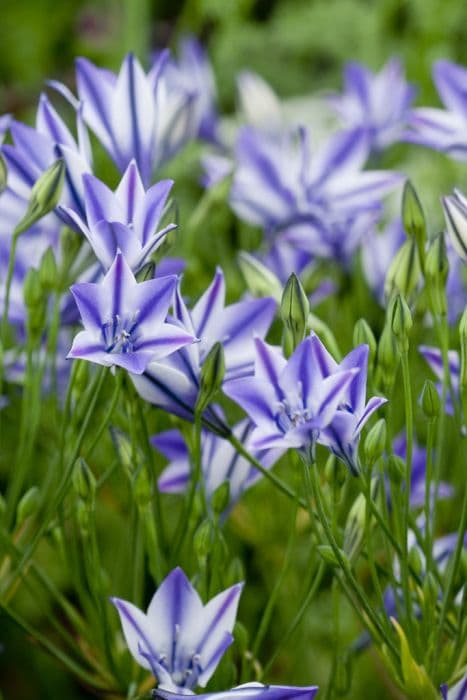Star of Bethlehem Ornithogalum umbellatum

ABOUT
The plant commonly known as the Star of Bethlehem has a distinctive appearance characterized by its rosette of narrow, green leaves and a flowering stalk that holds an umbrella-like cluster of flowers. Each bloom in the cluster has a classic star shape, with typically white petals that exhibit a greenish or bluish stripe down their centers on the underside. The blossoms can have a modest yet luminescent quality, which makes them highly appealing in gardens and as cut flowers. Though I must refrain from including specific dimensions, the leaves appear as elongated blades emanating from a central point at the plant's base. The flowering stalk rises above the foliage, offering a contrast with the softer textural appearance of the leaves. The overall impression of the plant is one of delicate simplicity and refined beauty, with its white blooms evoking a sense of purity and tranquility in its natural setting.
About this plant
 Names
NamesFamily
Asparagaceae
Synonyms
Star Of Bethlehem, Dove's Dung, Eleven O'Clock Lady, Sleepydick, Nap-At-Noon, Grass Lily
Common names
Ornithogalum angustifolium, Ornithogalum sphaerocarpum, Hyacinthus umbellatus, Loncomelos umbellatus, Ornithogalum lacteum, Ornithogalum vulgare, Stellaris scilla, Unifolium umbellatum.
 Toxicity
ToxicityTo humans
The plant commonly known as Star-of-Bethlehem (Ornithogalum umbellatum) contains toxic compounds, particularly cardiac glycosides, which can be harmful if ingested. The toxicity level in humans is considered to be low to moderate. However, if any part of the plant is ingested, symptoms of poisoning may include nausea, vomiting, diarrhea, and abdominal pain. Severe cases, though rare, could involve irregular heartbeats, tremors, and collapse due to the effect of cardiac glycosides on the heart. Immediate medical attention is advised if ingestion occurs.
To pets
Star-of-Bethlehem is also toxic to pets. Similar to its effects on humans, the plant contains cardiac glycosides that can lead to poisoning if any part of it is ingested by animals. The symptoms in pets can include vomiting, diarrhea, drooling, and lethargy. In more severe cases, pets might experience abnormal heart rate, tremors, seizures, and possibly death. Prompt veterinary care is critical if a pet consumes any amount of Star-of-Bethlehem.
 Characteristics
CharacteristicsLife cycle
Perennials
Foliage type
Deciduous
Color of leaves
Green
Flower color
White
Height
1 foot [30 cm]
Spread
0.5 foot [15 cm]
Plant type
Bulb
Hardiness zones
4
Native area
Europe
Benefits
 General Benefits
General Benefits- Ornamental value: Ornithogalum umbellatum, commonly known as Star of Bethlehem, is valued for its attractive white flowers which add beauty to gardens and landscapes.
- Low maintenance: It requires minimal care once established, making it a convenient choice for gardeners of all skill levels.
- Drought tolerance: The plant is relatively drought-tolerant, reducing the need for frequent watering.
- Attracts pollinators: The flowers attract bees and other pollinators, supporting biodiversity.
- Easy to propagate: Star of Bethlehem can be easily propagated through bulb offsets, allowing gardeners to expand their plantings.
- Rapid growth: It grows quickly in the right conditions, providing a fast garden filler.
- Durability: The plant is known for its hardiness and can survive in a range of soil types and conditions.
- Ground cover: When planted in groups, it can act as a ground cover, reducing weed growth and soil erosion.
 Medical Properties
Medical Properties- Diuretic: Traditionally used to promote the production of urine.
- Expectorant: Used in folk medicine to help expel mucus from the respiratory tract.
- Cardiac: Historical references suggest use to treat heart conditions.
 Air-purifying Qualities
Air-purifying QualitiesThis plant is not specifically known for air purifying qualities.
 Other Uses
Other Uses- Ornithogalum umbellatum, commonly known as Star of Bethlehem, can be used for decorative purposes in floral arrangements due to its attractive and star-shaped white flowers.
- The plant's bulbs can be crushed to produce a glue-like substance that can be used in traditional crafts or as a natural adhesive for paper.
- Pressed Star of Bethlehem flowers can be used in the art of flower pressing to create botanical displays or for inclusion in handmade paper products.
- Some cultures historically used the sap of Star of Bethlehem for stiffening cloth, similar to starch, due to its viscous consistency when extracted.
- The fibers from the plant's leaves can be woven or braided to create small decorative items, as they are fairly strong and durable once dried.
- Dried Star of Bethlehem flowers can be used to make ornamental potpourri mixtures, adding fragrance and visual appeal.
- The plant may serve as a tool for teaching botany and plant biology, providing a live example for the study of monocots in educational settings.
- Star of Bethlehem is sometimes used in landscaping as a ground cover in garden designs due to its tendency to spread and blanket areas.
- Photographers might find the plant an excellent subject for practicing macro photography because of its detailed and visually interesting blossoms.
- In the culinary arts, although not commonly consumed nor widely recommended, the bulbs have been historically used as a starch source after thorough processing to remove toxins.
Interesting Facts
 Feng Shui
Feng ShuiThe Star of Bethlehem is not used in Feng Shui practice.
 Zodiac Sign Compitability
Zodiac Sign CompitabilityThe Star of Bethlehem is not used in astrology practice.
 Plant Symbolism
Plant Symbolism- Purity: The star-shaped white flowers of Ornithogalum umbellatum, commonly known as Star of Bethlehem, are often associated with purity due to their color and delicate appearance.
- Hope: This plant is seen as a symbol of hope because it blooms in the spring, signaling the end of winter and the onset of warmer, longer days ahead.
- Innocence: Similar to purity, the white blossoms can represent innocence, making the flower a common choice for wedding bouquets and christenings.
- Forgiveness: In Christian symbolism, the Star of Bethlehem is associated with the birth of Jesus Christ and, by extension, forgiveness and the chance for a new beginning.
- Guidance: The common name references the biblical Star of Bethlehem, which guided the Wise Men to Jesus. Thus, the flower can symbolize guidance, direction, and navigation in life.
 Water
WaterStar of Bethlehem requires moderate watering, and it's important not to overwater to prevent root rot. During the growing season, typically in the spring and early summer, water when the top inch of the soil feels dry, which may be about once a week, with about half a gallon for an outdoor plant, depending on the size and the weather conditions. After the flowering period and during the dormant season in late summer and fall, reduce watering significantly, allowing the soil to dry out completely before watering lightly, if at all.
 Light
LightStar of Bethlehem thrives best in full sun to partial shade. Place it in a location where it can receive at least 6 hours of direct sunlight daily, but also has some protection from the harsh afternoon sun. Dappled sunlight is ideal, especially in regions with very hot summers.
 Temperature
TemperatureStar of Bethlehem is hardy and grows well in a wide range of temperatures, generally between 35°F and 75°F. It can survive minimum temperatures down to about 20°F and can tolerate brief periods of cold down to 10°F. For optimal growth, maintain a temperature around 60°F to 70°F.
 Pruning
PruningPruning Star of Bethlehem is generally not necessary, but you may remove spent flowers after blooming to encourage tidy growth and potentially additional blooms. Prune any yellow or brown leaves to maintain plant health. The best time for pruning is immediately after the flowering has ceased.
 Cleaning
CleaningNot needed
 Soil
SoilStar of Bethlehem thrives in a well-draining soil mix with a pH of 6.0 to 7.0. A blend of loamy soil, sand, and peat works well for good drainage and moisture retention.
 Repotting
RepottingStar of Bethlehem typically doesn't need frequent repotting. It's advisable to repot every 2-3 years or when bulbs multiply and become crowded in their pot.
 Humidity & Misting
Humidity & MistingStar of Bethlehem prefers moderate humidity levels but is quite adaptable. Average indoor humidity is often sufficient for this plant.
 Suitable locations
Suitable locationsIndoor
Place in bright, indirect light and well-draining soil for Star of Bethlehem.
Outdoor
Plant in well-draining soil with full sun to partial shade.
Hardiness zone
4-9 USDA
 Life cycle
Life cycleStar of Bethlehem (Ornithogalum umbellatum) begins its life cycle as a bulb, which remains dormant underground during winter. In spring, the bulb sends up linear leaves and a flowering stalk, culminating in an umbel of white, star-shaped flowers. After flowering, typically from April to June, the plant undergoes pollination, which can occur through self-pollination or with the help of insects. The seeds develop in a capsule and, once mature, they are dispersed near the parent plant. The foliage then dies back, and the plant reenters a dormant phase during the late summer and fall. Beneath the soil, the bulb divides, creating offsets or 'daughter bulbs', thus preparing for the next generation and expanding its presence in the growing area.
 Propogation
PropogationPropogation time
Spring
Star of Bethlehem can be propagated through dividing the bulb clusters. This is typically done after the plant has finished flowering and the leaves have died back, which is usually in late summer or early fall. To propagate, carefully lift the bulb clump from the soil, using a garden fork or a spade to loosen the ground. Then, gently separate the smaller bulbs from the main bulb. These smaller bulbs, known as offsets, can be replanted immediately in well-draining soil at a depth of about 3 inches (approximately 7.6 centimeters) and spaced 4 to 6 inches (10 to 15 centimeters) apart to give them room to grow. This method is effective because the offsets are genetically identical to the parent plant and thus will produce a consistent display of flowers.









